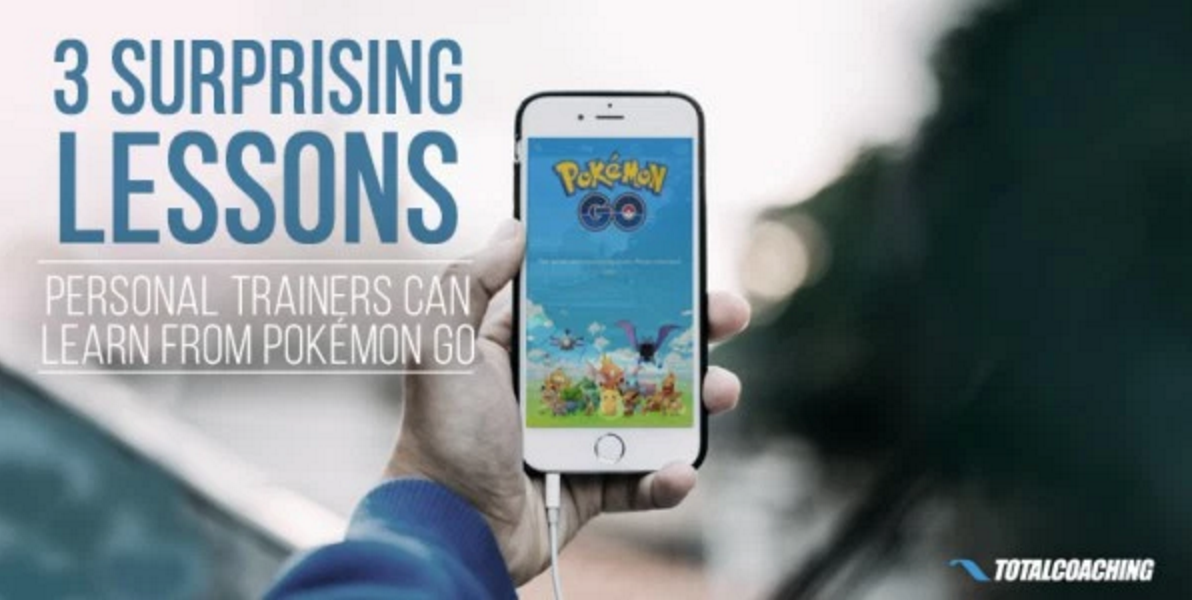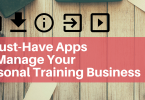Pokémon Go has been everywhere in recent months. All your friends have been playing it (maybe you have been too!), and everyone has definitely been talking about it.
Just how popular has Pokémon Go become?
A recent analysis found:
- There have been 75 million downloads so far.
- A whopping $1.6 million is spent on in-app purchases daily.
- The app has 21 million daily visitors.
All of this has lead to making it the #1 ranked app, beating Facebook, Instagram, and Twitter. But what does this have to do with you? Well, surprisingly, a lot.

While you may not be able to bring virtual reality into your training sessions, you can use many of the elements that are pervasive in the game to motivate and excite your clients.
Here are the lessons that you, as a personal trainer, can take from the latest video game craze to help clients be more successful and excited about fitness:
#1. Gamify Your Sessions
Gamification is a buzzword in education right now because it’s one way educators have found to keep students engaged.
Gamification is also part of the success with Pokémon Go; gaming on a worldwide level motivates users to chase after Pokémon characters—even to the point of danger at times!
Gamify a task and people are much more likely to engage and succeed.
Gamification can keep your clients engaged and excited about their sessions as well. To gamify their workouts, try these ideas:
AMRAP (As Many Reps As Possible):
Pit your clients against the clock with an AMRAP workout. While this won’t be appropriate for every session, it can be useful on days when you can tell your client’s not feeling it.
End the sessions with a 10 or 15-minute AMRAP to get their heart rate up and burn them out completely. Do this once a week or once a month so they can compete against themselves time and time again.
Adaptive athletes took the Tennis Stadium floor during the Games for a six-minute AMRAP. https://t.co/YBJb2w5NCg
— The CrossFit Games (@CrossFitGames) August 13, 2016
Create Levels:
You likely “level” your programs in some way, right? Whether you use linear or non-linear periodization, you plan these “level-type” progressions to help clients see success without burning out or getting bored. Make this more transparent with your clients, treating each new period as the "next level" that they aim to conquer.
#2. Create Attainable Goals and "Reach" Goals
You know the benefit of setting goals for clients: it increases adherence and motivation as clients feel great hitting each new milestone.
This is a large part of Pokemon Go as well, but with a twist...
There are easy-to-catch Pokemon creatures, and then there are the rare ones, and even though the rare ones are REALLY hard to get, players keep trying. You can only imagine how excited they are when they finally get catch one.
Went Pokémon hunting all weekend and finally caught cheerleader Groot. pic.twitter.com/5GDWwI7cyN
— Jason Leavey (@JasonTheGamer) August 22, 2016
When working with a client, instead of setting only “attainable” goals, or goals that your clients are comfortable with, set some “reach” goals as well. These should still follow the SMART style (Specific, Measurable, Attainable, Relevant, Time Based), but the difference is your client isn’t so sure they can reach them—but you are.
You work with your clients towards both goals, and when they finally hit a “reach” one, you’re a superstar and they’re on top of the world!
This is great for you and your client.
#3. Track Success with Tech
Everything is tracked in Pokémon Go—how many Poké Balls you have, the amount of Pokémon you’ve caught, and more. Seeing these stats is motivating: "I have to get this Pokémon, or I need to find a Pokéstop to refill."
While the use of tech in the fitness world is still up for debate with regards to effectiveness and reliability, it could be a great way to empower your clients while keeping them engaged.
Here are a few ways you can use this Pokémon lesson with your clients:
- If your client already has a fitness tracker, set daily or weekly goals and leave it up to them to track. Work with them to come up with rewards for hitting certain milestones—one reward could even be a half-priced workout or free group class with two of their friends.
- If you have a heart rate monitor, set a goal heart rate for each session and have your client track throughout. They’ll know when they need to start working harder or when they can dial it down, based on that goal.
- If they don’t have a tracker, use a program like Total Coaching. With this program, clients can easily track their progress and successes, including weight, personal goals, minutes invested, and more. Suddenly, your client can see their progress and think: "I need to run once more this week" or "I lost an extra pound last week!" - Watching those metrics move up and down is more motivating than you might imagine!
Pokémon Go may seem unrelated to personal training, when in fact, the two are very intertwined. What your clients love outside of training can likely be brought into training to keep them engaged and excited. Consider how you can take these ideas to your clients to help both of you be more successful.




